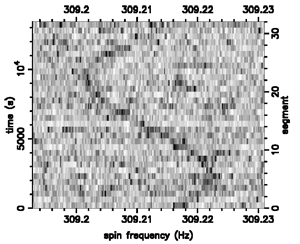WARNING: This website is obsolete! Please follow this link to get to the new Einstein@Home website!
The Einstein@Home Arecibo Radio Pulsar search: Topic 3 |
|
How does our search method work? |
[previous] [home] [next] |
||||
|
Our search is a a "blind search". A priori we do not know the exact distance, spin frequency, and orbital parameters of the radio pulsar that might be hidden in a data set. We have to search over a wide range in these parameters to maximize detection probability. Interstellar space is filled with clouds of gas and dust. Some of these clouds have temperatures of about 8,000 K and contain free electrons. These clouds will disperse radio waves travelling through them, meaning that higher radio frequencies arrive earlier than lower ones. The more electrons in the gas along the line of sight, the larger this time-delay. Radio telescopes observe a wide band of radio frequencies, so this dispersion has to be corrected for. Since the exact amount of dispersion depends on the unknown distance to the pulsar and the number of electrons along this distance we correct for 628 trial values of dispersion and search each of the resulting data sets independently. This process is called "dedispersion" and done on the Einstein@Home servers. Since we are ignorant of the orbital parameters of the binary we have to try thousands of possible orbital templates, each corresponding to a different pattern of Doppler spinup and spindown. For each of these templates the data are corrected for the full Doppler effect of the corresponding orbit. This is the first step done on the computers attached to the project. The next step is to test whether there is a radio pulsar present in that data set on that (or a similar) orbit. This is done by using a frequency analysis (Fourier transform) that will recover the spin frequency without smearing. Because the signals of radio pulsars are not sinusoidal but pulsed, the frequency analysis will show frequency components at the fundamental frequency (the intrinsic spin frequency) and at higher harmonics (integer multiples of the fundamental frequency). Summing these components is a well-known trick in pulsar searches and significantly increases the sensitivity of the search. This summation is the last step done on the users' computers. Finally a list of the most significant candidates is reported back to the Einstein@Home servers and analyzed by the project scientists. |
|
Last updated on 10 June 2009
This material is based upon work supported by the National Science Foundation (NSF) under Grants PHY-1104902, PHY-1104617 and PHY-1105572 and by the Max Planck Gesellschaft (MPG). Any opinions, findings, and conclusions or recommendations expressed in this material are those of the investigators and do not necessarily reflect the views of the NSF or the MPG.
Copyright © 2025 Einstein@Home

